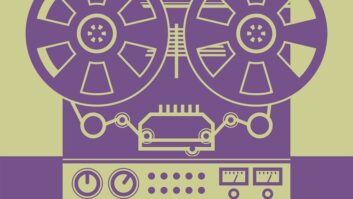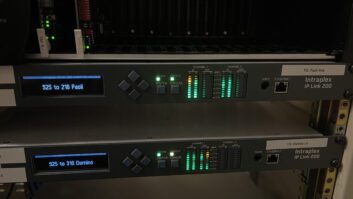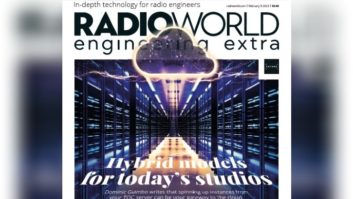AM longevity
Apr 1, 2004 12:00 PM
Having read the Reader Feedback section in the January issue of Radio magazine, I must wholeheartedly agree with Jim Jenkins. AM radio is far from dead, despite what the million dollar so-called consultants may tell us. I know of many AM stations, like the former WBYM, that made a very good profit by playing country music with real jocks 18 hours a day. The key to AM radio is to not treat it like a joke to begin with. Thinking that no one listens to AM is flat wrong. The aforementioned station won many listeners from the FM offerings out there by being community-minded and just by getting back to the basics of old-fashioned radio.
Corporate radio is ruining this business. So many good stations have been destroyed by taking on new corporate owners, such as WCMS in Virginia Beach. Despite being the oldest continuous country station in the world, it has been reduced to automation only, and even its very high ratings didn’t stop the suits from tearing it apart. How I long for private radio ownership to return in this country.
David R. Lyons
fmr. production director, WBYM
Carrollton, VA
I’d like to second Jim Jenkins’ letter in the January issue of Radio magazine. A �consultant� is all too often the trendy guy-du-jour who uses your watch to tell you what time it is, and then walks off with it. After 38 years in radio, I have observed that most stations in most situations would be better off spending the money they allocate for consultants, to hiring the best people they can and letting them do their jobs, rather than retaining some off-premises guy to second-guess their own people.
As far as digital goes, the critical issue is whether the listener and sponsor will see enough benefit, net of the serious technical complications that the IBOC system apparently presents, to justify purchase of relatively expensive new radios. The consensus seems to be, at least so far, �almost certainly not.� The average listener who wants to hear a few tunes and the traffic and weather on the way to work or who wants to check out Rush or Paul Harvey doesn’t care about technology. He just wants a little information or entertainment that sounds acceptably good.
Again, I agree with Jim: as an industry, our shortfall isn’t technological; it’s programming � starting with some of the vile stuff that’s generating so much unnecessary controversy these days. That’s where we should be focusing our attention, rather than trying to fix audience problems by simply buying some new box for the chief engineer to install.
Robert C. Savage
owner, general manager
WYSL-AM 1040
Avon, NY
IBOC shmi-boc, I’m not convinced yet
I am careful about panning new ideas. There are some smart folk out there that have created an amazing day and age with digital dexterity. Still, IBOC worries me on a number of levels, some of which I cannot quite put my finger on. With roughly 20 stations as a contractor, the first problem in developing a working understanding of IBOC is time; there ain’t any and I don’t think I’m unique. I don’t think I largely care about that, yet, even with my first small-market hybrid transmitter install coming up within a week or two. The hybrid is a handsome, 40 percent efficient box with enough bundled connectors to remind me of my first Heathkit. It came with lots of manuals, including a 100-page schematic book in large format. A 1.5kW TPO will require about 10kW of utility service. I’m sure it will work even though I swear the factory tried to hide Serial No. 1 on the nameplate.
I don’t care about fully understanding the box because there will never be any field repair applied to it at the discrete component level. From a small and medium market perspective, my concerns go past this.
I am old enough to have witnessed the migration from AM to FM, then back to AM when, once again, we all discovered that what created listeners was creative programming (e.g. AM talk radio). So, the serviceable but relative low fidelity AM medium has no trouble reigning king when it is programmed well. The lesson is that the modulation method is important but it is not the key to success. The migration to digital, by any method, is axiomatic; it is going to happen. But I submit that the necessity of IBOC is secondary to the shear technical momentum and some questionable thinking that is driving it forward.
The hype about digital quality strikes me as non sequitur, promising audio bandwidth I cannot hear from program sourcing that can barely reach analog’s 15kHz bandwidth as it is. Is this a solution looking for a problem? It will be consumed by listeners largely in a mobile environment, which is not exactly a quality listening room. Optionally, it will be in the office on a clock radio that falls short of a Bose. Sure, some folks will ultimately listen on their home digital receiver system, assuming they are not using the DVD at the time.
Many programmers now drool over the ability to further destroy the dynamic range because it can now be done so well, digitally. And they will want to do it with MP3 source material, re-encoded into an editor for real-time analog recording into a compressed WAV or MPEG2 automation so it can be played through an analog console feeding an Apt-x STL. With any luck, the AES out will then get re-encoded by the new digital processor AES input, come out at yet another rate where it can then achieve final conversion to 44.1kHz at the exciter AES input. This is a real scenario.
Without fail, when I try to explain why this might not be a good idea, the conversation stops immediately with a blank stare from the audience. During the silence, I am tempted to ask, �Is anyone home?� With any luck he will respond with by saying, �But, it’s digital! It has to be good!� Right.
We’re all on the same page; we are all going for quality with this mess and now we are going to add IBOC to further this aim.
This is less likely in the major markets where there is money and where the additional data capacity of IBOC when analog finally disappears might actually be profitable. In small and medium markets where current analog and/or digital subcarriers are a vast wasteland as it is, one can be assured that today’s small-market corporate bean counters, who have never seen a transmitter, will always select the lowest common denominator when it comes to operational quality. So, please don’t insult my intelligence by suggesting adding IBOC to this is a necessity. Try something else.
The development of digital studio LAN source routing, uncompressed digital STLs and companion processors has, in its own right, done tremendous good in improving the radio facility, providing the station starts with something other than MP3 or MP4 sources. From there, I’m not so sure, and editorialists can do me a favor: quit telling me how wonderful IBOC is. Start telling me how wonderful it could be if only stations would do it correctly. And teach me how in as few a words as possible. Remember, I’m a contractor. I don’t have time but I have fooled myself into thinking I’m intelligent. Don’t stop with me. The guy to whom you really have to get is the corporate bean counter and I don’t know anyone who likes the thought of that job.
Be very concerned about solid-state IBOC obsolescence. In 2001, I retired a low-efficiency 1990 solid-state FM when its modules could no longer be repaired. After puckering over the cost of a full refit, the choice was clear. It was more practical to put in a decent 1985 tube transmitter. It cost less, runs better and the power bill went down. This problem now affects perfectly good analog FM exciters, IPAs and consoles. My crystal ball is boiling with images of $30,000 solid-state IBOC refits for Class A stations, that create a seizure in the manager’s office.
I managed stations for 20 years until I returned to engineering. As a contract engineer I am very much an oxymoron but consider it might give me a little different perspective than the technical purist.
When the subject of IBOC on a small-market station is raised, I ask, �How will this purchase go to your bottom line as a startup operation? You can always add digital, later.� Those blank stares really spook me.
IBOC comes with the anvil of high capital cost with a license that looks suspiciously similar to a BMI/ASCAP contract. Do you think the licensor will really care about you when the introductory deal is over? Sure it will. I have this horrible image of someone showing up with a miner’s hat digging for the bottom line. In a small market, that could require alchemy, creating gold out of nothing. In the pending install, the licensee is now puckering a little suggesting that the STL might be Internet streaming.
What made me think that this might happen? But, that hybrid sure is pretty.
Richard J. Boekeloo
owner
DB Broadcast Services
Brunswick, GA
Variation on a theme
Besides the big cost to stations and listeners, which really does little for the audio quality, FM IBOC is not really IBOC, but puts digital data on the two adjacent channels. This has already resulted in complaints from listeners. And the audio time delay of the system is another headache. I have already said that I will not install it. The big ones to gain are the equipment manufacturers.
Stanley Swanson
KBNL, Laredo, TX
[email protected]
The on-channel and adjacent-channel debate resurfaces from time to time. It’s true that the data is placed on either edge of the analog signal, but because it borders the center channel and occupies nearly the same spectral mask, it is considered on-channel. The ongoing efforts to call it an in-band adjacent-channel channel (IBAC) technology will not change it.
The system audio delay has been discussed as well. Stations that want to adopt IBOC will need to make some changes to deal with the inability to monitor directly off the air. System delays from digital processing, digital STLs and remote feeds have been introducing small amounts of delay for some time. If a station is going to install IBOC technology, it will have to account for the system delay and build it into the overall costs.
Opinions on IBOC vary greatly and cover the extremes of support and opposition. We at Radio magazine follow the developments closely and report on what is happening, but the final decision to install the technology or ignore it is up to individual stations.
Chriss Scherer, editor
�Appy about the killer app
Hey Chriss, we loved your March 2004 Viewpoint on the killer app. Is your Viewpoint on the Web anywhere? We’d like to put it in our daily clips about tech stuff.
Jenny Lawhorn
senior manager, media and public relations
NPR
Washington, DC
Indeed it is. Each issue in its entirety is posted online atwww.beradio.com. Additional material is also available online, such as additional photos for a Facility Showcase, Industry Links and our Buyers Guide.
Chriss Scherer, editor












